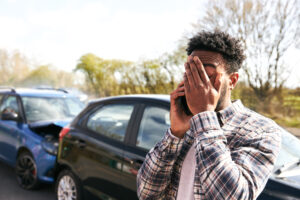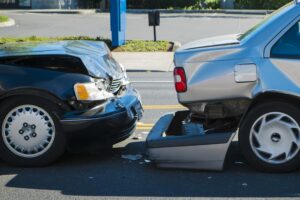 Getting rear-ended can happen to anyone, anywhere, at any time. One moment, you’re stopped at a red light or slowing down in traffic, and the next moment, another car crashes into your back bumper.
Getting rear-ended can happen to anyone, anywhere, at any time. One moment, you’re stopped at a red light or slowing down in traffic, and the next moment, another car crashes into your back bumper.
These accidents might seem simple on the surface, but determining who’s responsible isn’t always as straightforward as you might think. While the driver who hits you from behind usually bears responsibility, there are situations where fault becomes more complicated.
You need a lawyer who understands how fault works in rear-end collisions to protect your rights and get the compensation you deserve. Insurance companies don’t always play fair and often try to shift blame or minimize payouts. That’s why working with a car accident attorney can make all the difference in your case outcome.
Key Takeaways: Who Is At Fault for Rear-end Crashes?
- General Presumption: The rear driver is usually presumed to be at fault.
- Common Exceptions: The front driver may be fully or partially at fault for sudden and unnecessary braking, having broken brake lights, or making an illegal maneuver.
- Determining Factor: The core issue is negligence—which driver failed to exercise reasonable care?
- You Need Evidence: Police reports, witness statements, vehicle data, and video footage prove fault.
How Rear-End Accidents Happen
Rear-end crashes happen when one vehicle hits another from behind. They’re one of the most common types of car accidents and can range from minor to severe.
These accidents often occur when drivers follow too closely or aren’t paying attention, leaving them little time to stop. Most rear-end accidents happen in heavy traffic, construction zones, or areas with frequent stops. They can also occur on highways when traffic suddenly slows down.
The severity of the accident depends on factors like speed difference, vehicle size, and whether the front car was moving or stopped. High-speed crashes can cause serious injuries, especially when larger vehicles hit smaller cars.
Is the Rear Driver Always At Fault in a Rear-End Collision?
Traffic laws in most places require reasonable and prudent following distances. Drivers must maintain enough space between their car and the vehicle ahead to stop safely if traffic conditions change suddenly. This rule exists because the driver behind has the best view of what’s happening ahead and the most control over whether a collision occurs.
When someone hits you from behind, they usually violate this basic rule. They were either following too closely, driving too fast for conditions, or not paying proper attention to traffic. The law expects drivers to adjust their following distance based on speed, weather, visibility, and traffic conditions.
This presumption makes sense from a practical standpoint. The driver behind can see brake lights, turn signals, and traffic conditions ahead. They have the opportunity to slow down, change lanes, or take other actions to avoid a collision. The driver in front typically has no way to prevent getting hit from behind.
However, this general rule isn’t absolute. There are situations where the front driver might share responsibility or even bear primary responsibility for a rear-end crash. Understanding these exceptions is important for both drivers and their insurance companies.
When Might the Front Driver Bear Fault?
While rear-end accidents usually result from the following driver’s negligence, several situations can shift or share fault differently. These exceptions require careful investigation and legal analysis to determine how responsibility should be allocated.
Sudden stops without reason can sometimes make the front driver partially responsible. If someone slams on their brakes in the middle of traffic without apparent cause, they might share fault for the resulting accident. However, proving this requires showing that the stop was truly unreasonable and unexpected under the circumstances.
Broken brake lights create another potential exception. Drivers rely on brake lights to know when the car ahead is slowing down. If your brake lights aren’t working and someone hits you from behind, you might share responsibility for not maintaining your vehicle properly. Most states require working brake lights, and violations can contribute to accident liability.
Illegal stops or sudden lane changes can also shift fault. If someone stops in a travel lane where stopping isn’t allowed or cuts in front of another car without leaving a safe following distance, they might bear responsibility for the resulting rear-end crash. These situations often involve emergency maneuvers that don’t give following drivers reasonable reaction time.
Backing up incidents represent a special category. If someone puts their car in reverse and backs into another vehicle, they usually bear full responsibility even though the contact occurred at their rear bumper. These aren’t true rear-end accidents in the traditional sense.
Distracted Driving and Rear-End Crashes
Distracted driving has become a leading cause of rear-end accidents in recent years. Cell phone use, texting, eating, adjusting radio stations, and dealing with passengers all take drivers’ attention away from the road ahead. When drivers aren’t watching traffic, they don’t notice when cars ahead start slowing down or stopping.
Texting while driving is particularly dangerous because it simultaneously involves visual, manual, and cognitive distractions. Drivers who are reading or sending text messages may travel hundreds of feet without looking at the road. At highway speeds, this blind driving almost guarantees an accident when traffic conditions change.
Even hands-free phone conversations can contribute to rear-end crashes. Research shows that talking on the phone, even with hands-free devices, can reduce reaction times and make drivers less aware of their surroundings. While hands-free devices are legal in most places, they don’t eliminate the cognitive distraction of conversation.
Other forms of distracted driving include eating, grooming, programming GPS devices, and reaching for items in the car. Any activity that takes attention away from driving increases the risk of rear-end collisions. Drivers who cause accidents while distracted face both legal and financial consequences for their choices.
Following Distance and Speed Factors
Proper following distance provides the foundation for preventing rear-end accidents. The traditional “three-second rule” suggests maintaining enough space so that three seconds pass between when the car ahead passes a fixed point and when your car reaches the same point. However, this rule needs adjustment based on driving conditions.
Highway driving requires greater following distances due to higher speeds. At 60 miles per hour, cars travel 88 feet per second. Even with good reaction time, stopping distances increase dramatically at higher speeds. Drivers who follow too closely at highway speeds often can’t stop in time when traffic ahead slows suddenly.
Weather conditions demand increased following distances too. Rain reduces tire traction and increases stopping distances. Snow and ice make stopping even more difficult. Fog limits visibility and reduces reaction time. Smart drivers adjust their following distance based on these conditions, but not everyone makes appropriate adjustments.
Traffic congestion creates challenges following distance situations. Stop-and-go traffic tempts drivers to close gaps between cars, but this increases rear-end crash risk. Professional drivers often maintain larger following distances in heavy traffic because they understand that small gaps don’t significantly improve travel time but greatly increase accident risk.
Vehicle condition affects stopping ability and required following distances. Cars with worn brakes, old tires, or heavy loads need more distance to stop safely. Drivers are responsible for understanding their vehicle’s limitations and adjusting their driving accordingly.
Multi-Vehicle Rear-End Accidents
Chain-reaction crashes involve multiple vehicles hitting each other in sequence. These accidents often start with one rear-end collision that pushes the struck vehicle into another car ahead. Determining fault in multi-vehicle crashes requires analyzing each collision within the larger accident sequence.
The driver who starts the chain reaction typically bears primary responsibility for all resulting damage and injuries. However, other drivers may share fault if they contributed to the severity of the crash through their own negligent actions. For example, someone who was following too closely might be partially responsible for hitting the car ahead even though they were also struck from behind.
Interstate pile-ups represent extreme examples of multi-vehicle rear-end crashes. These accidents often involve dozens of cars and result from combinations of factors, including weather, visibility, speed, and following distances. Investigating these crashes requires extensive analysis to determine each driver’s contribution to the overall accident.
Insurance coverage becomes complicated in multi-vehicle accidents because multiple policies may apply to each person’s damages. Understanding how coverage works and which insurance companies bear responsibility requires legal experience that most accident victims don’t possess.
Why You Shouldn’t Rely on the Insurance Company’s Assessment
Insurance companies use tactics to minimize payouts after rear-end accidents. Even when the fault seems clear, they’ll look for ways to reduce their financial responsibility. They are in business and must take care of their bottom line.
One of the common strategies used is that they might downplay the accident’s severity, calling it a “minor impact” or “fender-bender” to justify lower settlements.
They’ll also review medical records for pre-existing conditions, arguing that current symptoms aren’t caused by the accident. Insurance companies may offer quick settlements that seem generous initially but often fall short of covering all expenses. Once accepted, these settlements prevent victims from seeking more compensation.
Some insurance companies even monitor accident victims through surveillance or social media, looking for ways to dispute claims. They might take innocent activities out of context to reduce or deny compensation.
Proving Fault in Rear-End Cases
Building a strong rear-end accident case requires gathering evidence to prove what happened and who’s responsible. Your lawyer will develop a comprehensive approach to proving fault and damages.
Police reports provide official documentation but may not tell the whole story. Witness statements can offer independent verification of the accident, and their accounts often carry more weight than driver statements.
Physical evidence like vehicle damage, skid marks, and accident scene photos can show impact speeds and driver actions. Electronic data from vehicles, like event data recorders, can capture important information about speed and braking. Traffic camera footage and surveillance videos can also be valuable evidence but need to be preserved quickly to be useful.
The Role of Traffic Laws
Traffic laws provide the legal framework for determining fault in rear-end accidents. These laws establish specific requirements for following distances, speed limits, and driver attention that form the basis for liability decisions.
- Traffic laws help determine fault in rear-end accidents. They set rules for following distances, speed limits, and driver attention.
- Tailgating laws make it illegal to follow too closely, and violating these laws can be strong evidence of negligence.
- Speed limits may need to be adjusted based on conditions like heavy traffic or poor weather.
- Right-of-way laws help determine fault in complicated situations like lane changes or merging. Distracted driving laws can also impact rear-end accident claims, especially if the at-fault driver was using a cell phone or engaging in other distracting activities.
Getting the Legal Help You Need
Rear-end accidents may seem straightforward, but insurance companies often complicate straightforward cases. They have teams of adjusters, investigators, and lawyers working to minimize their payouts. You need experienced legal representation to protect your interests and ensure fair treatment.
Car accident attorneys understand the tactics insurance companies use and know how to counter them effectively. They have experience investigating rear-end crashes and know what evidence to look for.
You need legal representation when injuries are severe or when anyone disputes fault. Even minor rear-end crashes can cause significant soft tissue injuries that take time to fully develop.
Car accident lawyers work with medical experts to document all injuries and calculate fair compensation for current and future medical needs.
The value of legal help extends beyond just negotiating with insurance companies. If your case goes to court, you’ll need someone who understands courtroom procedures and can present your case effectively to a judge or jury. Most people lack the knowledge and experience needed to handle complex legal proceedings on their own.
FAQs About Rear-End Accident Claims
What is the first thing I should do if I am rear-ended?
Your first priority is safety. Move your vehicle out of traffic if possible, turn on your hazard lights, and check on all occupants for injuries.
Call 911 immediately to report the accident and request medical assistance, even if injuries seem minor. Avoid discussing fault at the scene. Simply exchange contact, vehicle, and insurance information with the other driver.
What kind of compensation can I recover in a rear-end accident claim?
In a successful claim, you may recover compensation for damages. These typically include economic damages like current and future medical expenses, lost wages, and vehicle repair costs.
You may also recover non-economic damages for pain and suffering, emotional distress, and loss of enjoyment of life.
How long do I have to file a lawsuit for a rear-end accident?
The deadline for filing a personal injury lawsuit is determined by your state’s statute of limitations.
This time limit varies significantly by state, but it is often between one and three years from the date of the accident.
If you fail to file a lawsuit within this window, you will lose your right to pursue compensation in court. It is critical to speak with an attorney long before the deadline approaches.
My car only has minor damage. Do I still need to see a doctor?
Yes. It is crucial to get a medical evaluation after any car accident, regardless of the vehicle’s damage.
Many common rear-end collision injuries, such as whiplash and other soft-tissue injuries, may not present symptoms for hours or even days.
Delaying medical care can not only harm your health but can also be used by insurance companies to argue that your injuries are not related to the accident.
Moving Forward With Confidence
Rear-end accidents can disrupt your life in many ways, from dealing with injuries and medical bills to handling vehicle repairs and insurance claims. You don’t have to navigate this complex process alone.
Experienced legal representation can ensure you get fair treatment and appropriate compensation for your losses.
The consultation process typically involves reviewing your case details, explaining your legal rights, and discussing possible strategies for moving forward.
Most car accident attorneys work on contingency fee arrangements, meaning you don’t pay attorney fees unless your case is successful.
Your focus should be on recovering from your injuries and getting your life back to normal. Let a qualified car accident lawyer handle the legal complexities of proving fault and fighting for your deserved compensation. The peace of mind that comes with professional legal representation is invaluable during this challenging time. Contact us!
